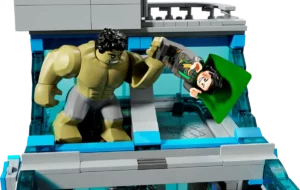The horror film has long played a leading role in the evolution of 3-D cinema. The visceral nature of the genre and the format?s immersive effects go together like, well, slashers and scream queens. In fact, the first big hit of the ?Golden Age? of 3-D was the classic chiller House of Wax (1953), starring Vincent Price. Audiences were captivated by the film?s stereoscopic visuals and Price?s performance in a role that would make him virtually synonymous with the genre.
Many of the most successful films of the first 3-D boom were, if not outright horror, jolting genre exercises such as Bwana Devil (1952), It Came from Outer Space (1953), The Mad Magician (1954) and Alfred Hitchcock?s Dial M for Murder (1954).
Perhaps the most significant of this crop of 3-D fright-fests was The Creature from the Black Lagoon (1954), the story of a team of archaeologists menaced by a prehistoric half-man, half-fish. Creature?s use of 3-D cinematography was limited but memorable. It spawned two sequels and its iconic Gill Man character rightfully took its place among the ranks of Universal?s famed monsters.
For various technical and financial reasons, Hollywood?s first 3-D craze was brief, but horror kept the format?s flame lit over ensuing decades in low-budget independent films. In 1961, a Canadian B-movie called The Mask chilled U.S. audiences with its eerie hallucinatory sequences shot in 3-D. Andy Warhol?s Frankenstein (1973) combined 3-D horror with another popular genre of the ?70s: softcore porn.
In the early 1980s, three-dimensional bogeymen stalked mainstream cinemas once again. Friday the 13th Part III (1982) was loaded with innovative 3?D imagery hailed for ?going past the lens??an effect in which objects appear to thrust from the screen into the theatre. The slasher sequel nearly doubled the box office of the franchise?s previous instalment and paved the way for major studio releases Jaws 3-D and Amityville 3-D the following year.
Due to the high costs and lingering technological challenges associated with the format, 3-D once again fell out of favour with studios and theatre owners in the mid?1980s. 3-D cinema was largely relegated to IMAX documentaries for most of the next 20 years. Gradually, however, the obstacles limiting widespread 3-D exhibition in the United States have been overcome. Today, the format is more attractive than ever before to the industry, artists and audiences.
Innovations in camera technology have reduced the cost of shooting in 3?D and allow filmmakers to create more exciting visual effects. And audiences are no longer subjected to the old headache and eyestrain-inducing red and blue (?anaglyph?) glasses. The predominant 3-D formats today, Real D and Dolby 3D Digital Cinema, use polarized glasses that are comfortable and provide crystal clear images.
3-D presentations of films such as Polar Express (2004), Chicken Little (2005), Beowulf (2007) and Journey to the Center of the Earth (2008) have dramatically outperformed their ?flat? screenings. In 2009 alone, no fewer than nine animated 3-D films are scheduled for theatrical release. Major franchises such as Shrek, Cars, Kung Fu Panda and Toy Story will make the leap to 3-D in their next instalments.
Given the format?s recent successes and promising new technologies on the horizon, the combination of 3-D and horror is likely to keep audiences on the edge of their seats for years to come.
In 1981, the slasher film craze was at its peak, driven by the box office success of films such as Halloween and The Last House on the Left. Then, out of Canada came the controversial low-budget sleeper My Bloody Valentine, whose enormous cult following shocked even its creators. Now, MY BLOODY VALENTINE 3D brings the fear factor to a new level with an immersive and utterly terrifying remake of the ultimate campfire story.
?This is the marriage of old school horror mixed with a great story and unbelievable new technology,? says director Patrick Lussier. ?There?s also some good old-fashioned gore. It?s the intersection of so many different things. We?re doing a 3-D movie; we?re doing a slasher film, but it?s much more than that. It requires a new way of looking at storytelling, and it?s a very exciting opportunity.?
All 3-D photography creates a three-dimensional illusion by recording a pair of 2-D images with two cameras or lenses set slightly apart. By providing each of the viewer?s eyes with a slightly different image of the same scene, 3-D produces an illusion of depth and volume.
?When I first experienced 3-D, it was a gimmick,? producer Jack Murray adds. ?It got people in the seats because they?d never seen it before. But it wasn?t about storytelling. It was a carnival trick, just a series of opportunities to set up the next moment where something would come out into the audience. That?s not what we?re doing in this film. We?re letting the 3-D fill out the environment we?re working in, and, at the same time, finding those moments where that third dimension makes it even scarier.?
Michael Paseornek, president of Lionsgate and executive producer of MY BLOODY VALENTINE 3D, elaborates: ?Our film uses traditional techniques with very few special effects, plus dimensional space to place viewers? attention where the director wants it. It immerses the audience in the environment, as opposed to just throwing effects at them. When you?re thinking about creating an environment of tension, if you?re in it?as opposed to watching it?it?s much scarier. Even down to the fact that when someone shines a flashlight around, it blinds you. And when the Miner swings his pickaxe at you, it swipes across you.?
When it came time to select a director for a state-of-the-art update of this blood-soaked classic, the producers found a filmmaker with just the pedigree they were looking for. Lussier, the editor of films including Scream, Dracula 2000 and New Nightmare, is a long time collaborator with legendary horror auteur Wes Craven.
?Patrick?s vision was very much tied to using 3-D to do what it does really well,? says Murray. ?There are times where 3-D needs to be right out there grabbing you, but there also need to be moments when the audience gets to relax and just enjoy the story. Along with other techniques and devices like prosthetics, stunts and visual effects, it lets the audience viscerally feel and experience the terror.?
For Lussier, the use of 3-D photography was an intrinsic part of the storytelling. ?The feeling of claustrophobia, the feeling of being trapped and the feeling of the horror are all heightened to a point that will take audiences beyond what they have seen before. The 3-D makes them feel even more like they?re part of the story. It envelops them, so they?re not just watching it as a spectator sitting in the front row, they are participating in the horror.?
None of this would have been possible without the groundbreaking technology and techniques created by Paradise FX, some of which were developed especially for MY BLOODY VALENTINE 3D.
?Once we knew we wanted to make the movie 3-D, we were fortunate enough to find Paradise,? says Lussier. ?Our stereographer Max Penner allowed us to do things that many 3-D filmmakers said couldn?t be done. We were constantly able to push the envelope because we had real pioneers in the realm of 3-D on our side. Everything was manufactured specifically for MY BLOODY VALENTINE 3D and our camera operator, Howard Smith, invented much of the equipment.?
Jensen Ackles, who plays Tom, says there?s one moment he is looking forward to seeing in the theater. ?The moment the Miner?s pickaxe first comes right out of the screen is going to be awesome,? says the actor. ?I?m going to be just as much of an audience member as everybody else, and I?ll be thrilled to see it.?
MY BLOODY VALENTINE 3D was shot in fully optimized 3-D using the new HD 4K format, which can record 4,000 pixel images at 30 frames per second, as opposed to the 2,000 pixels used by standard HD. The filmmakers used two state-of the-art digital cameras: the Red One and the Silicon Imaging SI-2K Digital Cinema Camera. Both are far smaller and lighter than conventional 2-D or 3-D cameras and more intuitive to operate.
The equipment and techniques used on the shoot were revolutionary even for veteran 3-D stereographer Max Penner. ?Earlier 3-D cameras had much bigger motors and were much more cumbersome to use,? says the film?s stereographer.
Another difference is that the new equipment uses neither tape nor film. Instead, digital images are stored on compact flash cards and later downloaded to a computer hard drive. The filmmakers were at the forefront of this cutting-edge technology, which Penner says created an on-set rhythm reminiscent of a 35mm film shoot.
One of the biggest benefits of the new digital format was it allowed live on-set playback of dailies in 3-D, providing far greater creative control of the image. ?In the past, we wouldn?t see how anything looked in 3?D until a month after shooting,? Penner says. ?On this project, what we were seeing on the monitor was what the audience was going to get in the theatre.
?All the 3-D you see in the film was done on the set,? Penner continues. ?We were able to dimensionalize the picture on the set in the same manner a focus puller makes his mark or a camera operator composes his schedule. The technology enabled us to look at the situation and judge what we needed right then and there.?
MY BLOODY VALENTINE 3D takes filmmaking into a new realm, according to Lussier. ?We have gone beyond what audiences have seen before, even in CG films. This is totally different because there?s always an artificial quality to that, and this is the actual real events. You are there and part of the story. It has an interactive quality unlike anything you?ve ever seen.?



